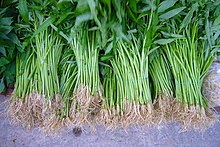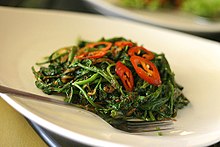Ipomoea aquatica: Difference between revisions
Jboltonnal (talk | contribs) |
|||
| Line 56: | Line 56: | ||
*[http://aquat1.ifas.ufl.edu/ipaqpic.html Aquatic, Wetland and Invasive Plant Particulars and Photographs] |
*[http://aquat1.ifas.ufl.edu/ipaqpic.html Aquatic, Wetland and Invasive Plant Particulars and Photographs] |
||
*[http://www.aphis.usda.gov/ppq/weeds/7cfr360-06.pdf USDA Noxious Weed Regulations (Possession in USA requires permit)] |
*[http://www.aphis.usda.gov/ppq/weeds/7cfr360-06.pdf USDA Noxious Weed Regulations (Possession in USA requires permit)] |
||
* [http://www.invasivespeciesinfo.gov/aquatics/alligatorweed.shtml Species Profile- Alligatorweed (''Ipomoea aquatica'')], National Invasive Species Information Center, [[United States National Agricultural Library]]. Lists general information and resources for Alligatorweed. |
|||
*[http://ss.jircas.affrc.go.jp/engpage/jarq/33-3/yoshihara/yoshihara.htm ''Helminths and Helminthiosis of Pigs in the Mekong Delta Vietnam with Special Reference to Ascariosis and Fasciolopsis buski Infection''] |
*[http://ss.jircas.affrc.go.jp/engpage/jarq/33-3/yoshihara/yoshihara.htm ''Helminths and Helminthiosis of Pigs in the Mekong Delta Vietnam with Special Reference to Ascariosis and Fasciolopsis buski Infection''] |
||
{{wikispecies|Ipomoea aquatica}} |
{{wikispecies|Ipomoea aquatica}} |
||
Revision as of 14:27, 16 February 2011
| Ipomoea aquatica | |
|---|---|

| |
| Scientific classification | |
| Kingdom: | |
| (unranked): | |
| (unranked): | |
| (unranked): | |
| Order: | |
| Family: | |
| Genus: | |
| Species: | I. aquatica
|
| Binomial name | |
| Ipomoea aquatica | |
Ipomoea aquatica is a semi-aquatic tropical plant grown as a leaf vegetable. It is known in English as Water Spinach, Water Morning Glory, Water Convolvulus, or by the more ambiguous names "Chinese spinach" and "swamp cabbage". It has many other names in other languages. It is found throughout the tropical and subtropical regions of the world; it is not known exactly where it originated.
Ipomoea aquatica grows in water or on moist soil. Its stems are 2–3 metres (7–10 ft) or more long, rooting at the nodes, and they are hollow and can float. The leaves vary from typically sagittate (arrow-head-shaped) to lanceolate, 5–15 centimetres (2–6 in) long and 2–8 centimetres (0.8–3 in) broad. The flowers are trumpet-shaped, 3–5 centimetres (1–2 in) diameter, usually white in colour with a mauve centre. The flowers can form seed pods which can be used for planting. [1]
Cultivation and culinary uses

Ipomoea aquatica is most commonly grown in East and Southeast Asia. Because it flourishes naturally in waterways and requires little if any care, it is used extensively in Malay and Chinese cuisine, especially in rural or kampung (village) areas.
It has also been introduced to the United States where its high growth rate has caused it to become an environmental problem, especially in Florida and Texas. It has been officially designated by the USDA as a "noxious weed"[2] (the term "noxious" refers to its effect on the environment, not to any toxicity)


The vegetable is a common ingredient in Southeast Asian dishes. In Singapore, Indonesia and Malaysia, the leaves are usually stir fried with chile pepper, garlic, ginger, dried shrimp paste (belacan/terasi) and other spices. In Penang and Ipoh, it is cooked with cuttlefish and a sweet and spicy sauce. During the Japanese Occupation of Singapore in World War II, the vegetable grew remarkably well and easily in many areas, and become a popular wartime crop.
In Chinese cuisine (Chinese: 空心菜; lit. 'hollow vegetable') there are numerous ways of preparation, but a simple and quick stir-fry either plain or with minced garlic is probably the most common. In Cantonese, the water spinach is known as 蕹菜 (Jyutping: ung3 coi3, sometimes transliterated as ong choy). In Cantonese cuisine, a popular variation adds fermented bean curd. In Hakka cuisine, yellow bean paste is added, sometimes along with fried shallots. The vegetable is also extremely popular in Taiwan, where it grows well.
In Thailand, where it is called phak bung (Thai: ผักบุ้ง), and in Burma, where it is called ga zun ywet, it is frequently stir-fried with oyster sauce or yellow soybean paste, and garlic and chillies. It can also be eaten raw, for instance with green papaya salad. There is concern that when eaten raw, the plant may transmit Fasciolopsis buski an intestinal fluke parasite of humans and pigs causing fasciolopsiasis.[3]
In Vietnam, ipomoea aquatica (known as rau muống) once served as a staple vegetable of the poor. In the south, the stems are julienned into thin strips and eaten with many kinds of noodles. It is used as a garnish as well. Ipomoea aquatica has become a common ingredient of Vietnamese cuisine.
In the Philippines, Ipomoea aquatica or kangkóng, is usually sautéed in cooking oil, onions, garlic, vinegar, and soy sauce. This dish is called "adobong kangkong". It is also a common leaf vegetable in fish and meat stews such as sinigang. There is also an appetizer in the Philippines called "crispy kangkong", in which Ipomoea aquatica leaves are coated with batter and fried until crisp and golden brown.[4]
In South India the leaves are finely chopped and mixed with grated coconut in order to prepare Thoran (തോരന്), a Kerala cuisine dish.
Cultural references

There is a belief in traditional Chinese culture that discourages extensive consumption of Ipomoea aquatica[citation needed] with the explanation that the hollow stem makes the person weak and hollow like the plant[citation needed], although this belief does not advocate refraining from eating the plant entirely[citation needed]. The elderly however are especially discouraged from consuming it[citation needed]. There is also a belief in Chinese culture that extensive consumption may result in muscle cramps[citation needed]. Despite this, it is a common vegetable in Asian cuisine.
References
External links
- Germplasm Resources Information Network: Ipomoea aquatica
- " Multilingual taxonomic information". University of Melbourne.
- Water spinach nutritional information from Kasetsart University
- Photo of heart-shaped variety
- Aquatic, Wetland and Invasive Plant Particulars and Photographs
- USDA Noxious Weed Regulations (Possession in USA requires permit)
- Species Profile- Alligatorweed (Ipomoea aquatica), National Invasive Species Information Center, United States National Agricultural Library. Lists general information and resources for Alligatorweed.
- Helminths and Helminthiosis of Pigs in the Mekong Delta Vietnam with Special Reference to Ascariosis and Fasciolopsis buski Infection
